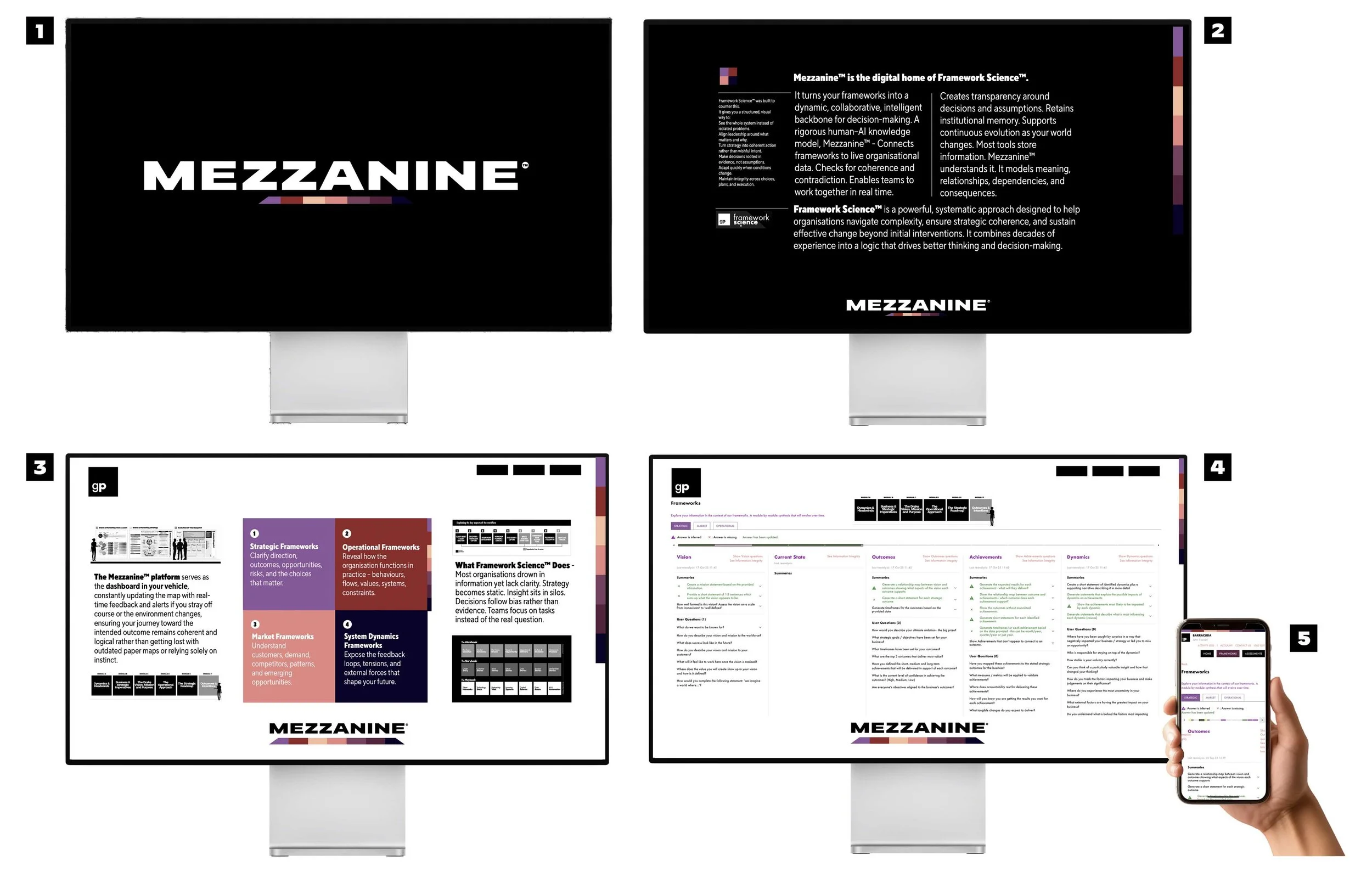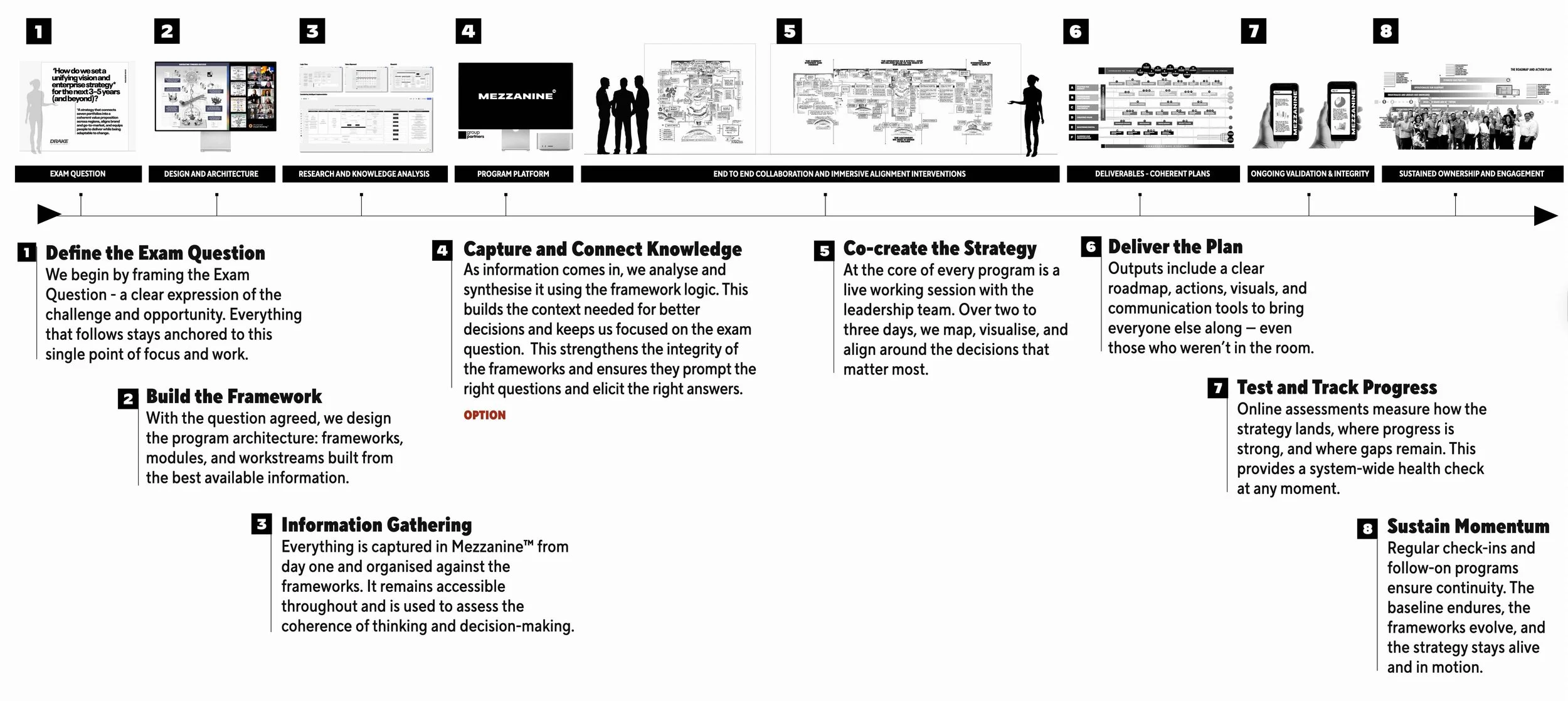Framework Science™
The clarity to understand complexity. The structure to act on it.
Complexity is not the enemy. The real risk is failing to understand it.
Framework Science™ helps leadership teams make sense of their organisation as a connected system. It turns scattered insight into a clear, shared understanding and supports decisions that hold together in the real world.
It gives you the structure to think clearly, the tools to act deliberately, and the means to adapt continuously.
What Framework Science™ Does
Most organisations drown in information yet lack clarity. Strategy becomes static. Insight sits in silos. Decisions follow bias rather than evidence. Teams focus on tasks instead of the real question.
Framework Science™ was built to counter this.
It gives you a structured, visual way to:
See the whole system instead of isolated problems.
Align leadership around what matters and why.
Turn strategy into coherent action rather than wishful intent.
Make decisions rooted in evidence, not assumptions.
Adapt quickly when conditions change.
Maintain integrity across choices, plans, and execution.
It is a wholly fresh approach - a disciplined way of thinking in a world that refuses to stay still.
How It Works
Everything begins by defining the Exam Question – the real challenge you must solve.
Not the loudest problem. Not the most convenient one. The right one.
From there, we work through four integrated lenses:
1. Strategic Frameworks
Clarify direction, outcomes, opportunities, risks, and the choices that matter.
2. Operational Frameworks
Reveal how the organisation functions in practice – behaviours, flows, values, systems, constraints.
3. Market Frameworks
Understand customers, demand, competitors, patterns, and emerging opportunities.
4. System Dynamics Frameworks
Expose the feedback loops, tensions, and external forces that shape your future.
Using these lenses, we co-create structured visual frameworks that capture reality in a form that teams can understand, work with, and improve.
How a Programme Actually Runs
The work begins the moment a programme is launched. The platform, the method, and the team move in sync. Here is what clients experience.
Stage One. Discovery
We set up the project and immediately begin building the knowledge base.
This includes:
a complete market analysis generated directly within Mezzanine™
all available documents, pre-reads, and source materials
the programme brief and the Exam Question
synthesised and anonymised notes from early calls
a version-controlled log of discussions and findings
At this point, the client is added to the platform, so early Q&A and inquiry have meaning.
When the available information is captured, we generate the first set of frameworks.
The AI analyses the knowledge base and attempts to populate modules across the relevant domains. Sources are always visible, so nothing emerges without provenance.
This early framework is intentionally unstable – incomplete modules, weak connections, and missing insight.
It serves one purpose: to reveal how current thinking stands up against the logic of the system.
Stage Two. Enrichment and Challenge
As interviews begin, we record and analyse the conversations ourselves.
We do not upload raw call transcripts. Instead, we extract meaning – new information, contradictions, clarifications, and system clues.
These feed back into the evolving frameworks.
At agreed points, we regenerate the frameworks to see how the system is developing.
Clients can challenge content, nominate new insight for promotion, or question logic directly through the Q&A tools.
This creates a constructive loop: evidence, interpretation, refinement, regeneration.
Stage Three. Intervention Sessions
This is where Structured Visual Thinking™ takes over.
Using the accumulated framework content, we build the large-scale visual versions and run a facilitated session with the leadership team.
We capture everything – the dialogue, tensions, breakthroughs, patterns – and map it directly to the frameworks.
This session often surfaces what the documents never show - Misalignments, blind spots, tacit knowledge, unspoken constraints, fundamental drivers of performance.
Stage Four. Refinement and Stabilisation
After the session stage, we upload the edited capture, remove misaligned or invalid source data, supplement missing details, and strengthen the integrity of the frameworks.
We then regenerate the frameworks again.
By now, they are close to stable – coherent, connected, and ready to drive decisions.
If any underlying source data is invalidated, the platform automatically removes it, along with any dependent content.
Integrity is built into the system, not applied afterwards.
What Makes Framework Science™ Different
It treats complexity as a feature, not a flaw.
The goal is not to oversimplify but to organise complexity into something understandable and usable.
It integrates strategy, operations, markets, and system dynamics.
Few methods connect all four. That is where coherence lives.
It is visual and built for human cognition.
Clear frameworks accelerate understanding and strengthen dialogue.
It is collaborative at its core.
Frameworks are made with people. This builds ownership and dissolves siloed thinking.
It protects rigour without killing flexibility.
Each organisation’s system is unique. The method respects that.
It is evidence-based.
Data, insight, experience, and research are woven into one coherent view.
It adapts as you learn.
The framework evolves with your world. It is a living system, not a fixed document.
Where Mezzanine™ Fits
Mezzanine™ is the digital home of Framework Science™.
It turns your frameworks into a dynamic, collaborative, intelligent backbone for decision-making.
Powered by a rigorous human–AI knowledge model, Mezzanine™:
connects frameworks to live organisational data
checks for coherence and contradictions
enables teams to work together in real time
creates transparency around decisions and assumptions
retains institutional memory
supports continuous evolution as your world changes
Most tools store information.
Mezzanine™ understands it.
It models meaning, relationships, dependencies, and consequences.
This is human and machine intelligence working within one structured epistemology.
Structured Visual Thinking™
This is the practice that brings Framework Science™ to life.
It uses large-scale visual working sessions where leaders see, question, and build the system together.
Structured Visual Thinking™ enables:
fast alignment
richer dialogue
better decisions
fewer blind spots
more coherent plans
clearer ownership
It is hands-on, collaborative, and grounded in real organisational logic.
The combination of Structured Visual Thinking™, Framework Science™, and Mezzanine™ creates a complete decision-intelligence environment.
What Clients Gain
Clarity
Teams see what is really going on.
Alignment
Arguments turn into understanding.
Better decisions
Choices are grounded, not guessed.
Momentum
Intent becomes coherent action.
Adaptability
The organisation learns faster and responds sooner.
Integrity
Plans, behaviours, and decisions hold together.
As one client said: ‘It shows the truth – including the things we usually avoid talking about.’
Where It Helps Most
Framework Science™ is most valuable when an organisation faces:
competing priorities
strategic drift
misalignment
transformation or integration
unclear customer value
operational friction
rapid market change
a system that feels more complex than controllable
In other words, most modern organisations.
The Science Behind It
Framework Science™ is built on a deep human–AI ontology with five layers:
Domains - Frameworks - Modules - Elements - Attributes.
This allows reasoning, pattern detection, integrity checks, and traceability.
It is the same structure that powers Mezzanine™.
This architecture is unusual because it models how people reason, not how data is stored.
It supports coherence, causality, and systemic understanding.
It is a designed epistemology for human and AI collaboration.
Everything begins with a conversation and the Exam Question.
Framework Science™ is a powerful, systematic approach designed to help organisations navigate complexity, ensure strategic coherence, and sustain effective change beyond initial interventions. It combines decades of experience into a logic that drives better thinking and decision-making.
The Core Purpose: Solving Complexity and Ensuring Logic
Framework Science is based on the premise that complex interconnections and variability characterise the business world, often leading organisations to rely on fixed processes or seek quick fixes that fail to deliver sustainable results.
Frameworks are the fundamental structures used to organise ideas, thoughts, and perspectives to create meaning that addresses a specific challenge, referred to as the "exam question".
The value of Framework Science™ for a client is that it provides:
Objective Response: Frameworks are designed to help respond objectively, logically, and consistently to the given challenge. They enforce a consistent approach without forcing a "one size fits all" solution.
Contextual Insight: Frameworks honour the client's context and account for variability. Instead of falling back on old techniques, they support critical thinking, map essential relationships, and tease out vital insights.
Systemic View: Frameworks encourage a systemic approach by highlighting the interdependence of topics that need consideration. This transcends functional silos, helping teams understand how everything connects to create value.
The Key Principle: Framework Integrity (FWI)
A central concept of Framework Science is Framework Integrity (FWI), which applies to the creation, maintenance, and adherence to a coherent, logical, and actionable declaration of intention.
For a client, achieving Framework Integrity ensures that the structure can be completely trusted as a tool for making important decisions:
Coherent Narrative: The modules join up to build the most cohesive story possible, ensuring everything "just makes sense". This means decisions are backed by clear logic.
Interdependence Captured: FWI recognises and captures the interdependence between content across modules. At a high level, this rigour results in an "equation" that clarifies: "based on what you want to achieve, this is what it will take!".
Clarity of Intent: FWI confirms that intentions and what success looks like are clearly defined, making the logic for what must be done to succeed transparent.
The Group Partners Context: Sustainability through Mezzanine™
Frameworks underpin everything Group Partners does and are the heart of every program, particularly within the Structured Visual Thinking (SVT™) approach. However, frameworks are living tools that must evolve as circumstances change.
The most significant value Group Partners provides is ensuring the client's initial investment in strategic clarity translates into sustained long-term execution.
Bridging Strategy to Action: While workshops create inspiration and ownership, teams often revert to traditional planning processes afterwards. Framework Science addresses the challenge of making conversational insights actionable and maintaining the structure and logic over time.
Mezzanine™ is the proprietary digital platform designed as the engine for Framework Science. GPOP™ makes frameworks accessible and sustainable.
Sustained Integrity: Mezzanine™ helps maintain the integrity of the framework by enabling teams to keep context current and identify potential deviations from the original intention. It is often referred to as the "conscience for the team," reminding everyone why actions are being taken and what success should look like.
In essence, Framework Science provides the blueprint for strategic clarity, and the Mezzanine™ platform offers the infrastructure to turn that blueprint into a continuously monitored, living operational guide.
Analogy: If your business challenge is like navigating an ancient, complex city to reach a specific, hidden treasure, Framework Science is the GPS system Group Partners provides. It defines your exact destination (the Exam Question/Vision). It builds a custom map (the framework modules) that plots all the critical relationships (Framework Integrity) among the streets, shortcuts, and potential pitfalls (Dynamics).
The Mezzanine™ platform serves as the dashboard in your vehicle, constantly updating the map with real-time feedback and alerts if you stray off course or the environment changes, ensuring your journey toward the intended outcome remains coherent and logical rather than getting lost with outdated paper maps or relying solely on instinct.








